Lecture 8 – Small circuits and escape swimming in the Xenopus model system
1/26
Earn XP
Description and Tags
Characteristics of synaptic inputs • Simple network principles • Pattern generation in Xenopus model system
Name | Mastery | Learn | Test | Matching | Spaced |
|---|
No study sessions yet.
27 Terms
Synaptic signals excite or inhibit the postsynaptic cell. What are the two postsynaptic potential? What does the graph look like for pre and post synaps?
• Excitatory postsynaptic potential (EPSP) – depolarization
• Inhibitory postsynaptic potential (IPSP) – hyperpolarization
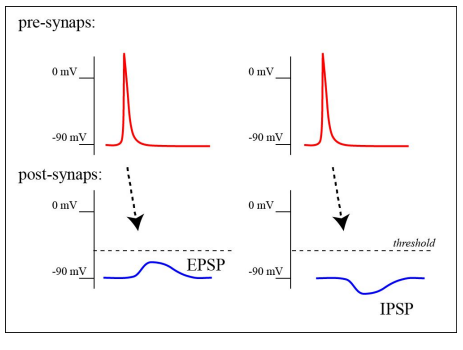
What is an Excitatory postsynaptic potential (EPSP). What does their amplitude depend on?
Depolarization in the post-synapse, shift in membrane potential toward a more positive value. Brings this closer to an action potential threshold.
their amplitude depends on the amount of neurotransmitter released and the number of receptors activated
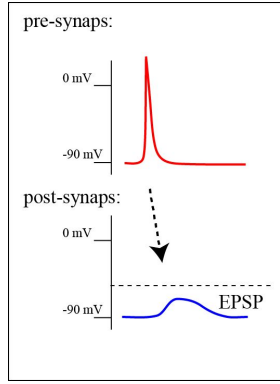
What are the neurotransmitters tha causes Excitatory postsynaptic potential (EPSP)
Glutamate -The primary excitatory neurotransmitter in the central nervous system. It binds to various receptors (like AMPA, NMDA, and kainate receptors) that allow positively charged ions (mainly Na⁺ and sometimes Ca²⁺) to enter the neuron.
AMPA Receptors: When glutamate binds to AMPA receptors, the ion channel opens, allowing sodium ions (Na⁺) to flow into the neuron and potassium ions (K⁺) to flow out. This influx of Na⁺ causes depolarization of the postsynaptic membrane, generating an excitatory postsynaptic potential (EPSP). AMPA receptors are responsible for the rapid excitatory signaling and fast synaptic transmission.
NMDA receptors also require glutamate and a co-agonist (glycine or D-serine) to open. They are unique because they are blocked by magnesium ions (Mg²⁺) at resting membrane potential. Upon depolarization (e.g., from AMPA receptor activation), the Mg²⁺ block is relieved, allowing Ca²⁺, Na⁺, and K⁺ to flow through the channel. The entry of Ca²⁺ is crucial for signaling pathways that lead to synaptic plasticity, such as long-term potentiation (LTP) and long-term depression (LTD).
Acetylcholine (ACh) - Particularly important in the neuromuscular junction and in certain brain regions, acetylcholine binds to nicotinic receptors on the postsynaptic membrane, allowing Na⁺ to enter and create an EPSP.
What is Inhibitory postsynaptic potential (IPSP)? Does it move further or closer to threshold?
Decreases postsynaptic neuron firing an action potential. IPSPs occur when inhibitory neurotransmitters, such as gamma-aminobutyric acid (GABA) or glycine, bind to receptors on the postsynaptic neuron. This binding opens ion channels that typically allow negatively charged ions (like chloride ions, Cl⁻) to flow into the cell or positively charged ions (like potassium ions, K⁺) to flow out. T
hese ion movements make the inside of the cell more negative, moving the membrane potential further from the action potential threshold.
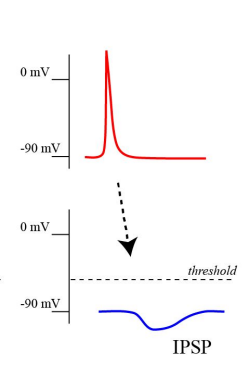
What inhibitory neurotransmitters are responsible for this?
GABA - The main inhibitory neurotransmitter in the central nervous system GABA binds to two main types of receptors:
GABA A receptors: Ionotropic receptors (Ligand-gated ion) that open chloride (Cl⁻) channels, allowing Cl⁻ ions to flow into the cell, making the inside more negative and hyperpolarizing the neuron.
GABA B receptors: Metabotropic receptors (GPCRs) that activate potassium (K⁺) channels, allowing K⁺ ions to flow out of the cell. This also makes the inside of the cell more negative and produces a hyperpolarizing effect
Glycine: Found in spinal cord and brainstem. Glycine binds to glycine receptors, which are ionotropic and also open Cl⁻ channels, allowing Cl⁻ to enter and hyperpolarize the postsynaptic membrane.
Where, when, and how inputs are received shape the response of the postsynaptic cell
Passive membrane processes (mostly) goven much the?
Integration synaptic input
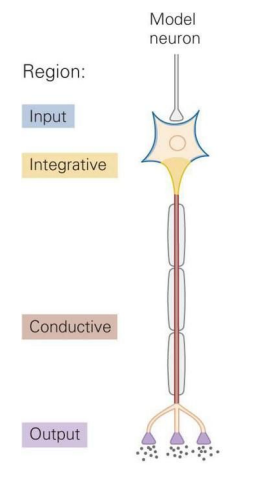
Action potential originate at the what?
Axon hillock
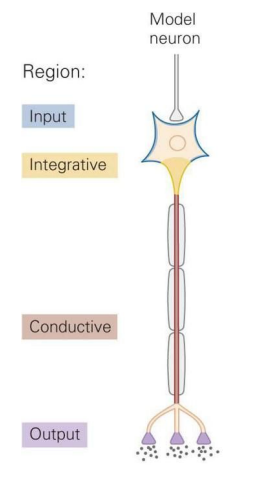
Excitatory Synapse are typically on …. at the dendritic spines. In CNS presynaptic neurons are typically …?
Dendrite.
Glutamatergic
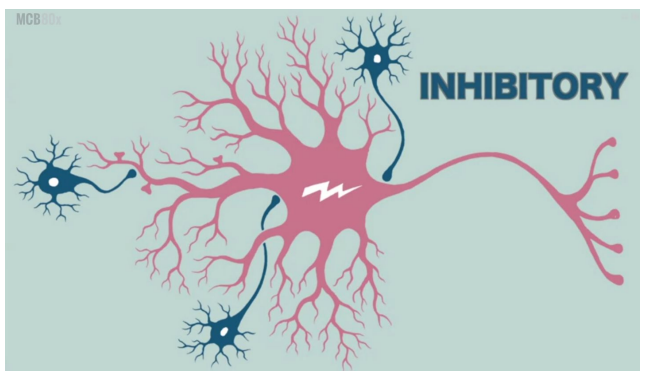
Inhibitory synapse are located on the? In CNS, presynaptic neurons are typically?
Dendrites and soma
GABAergic
On soma or axon hillock can have global effects on responsiveness
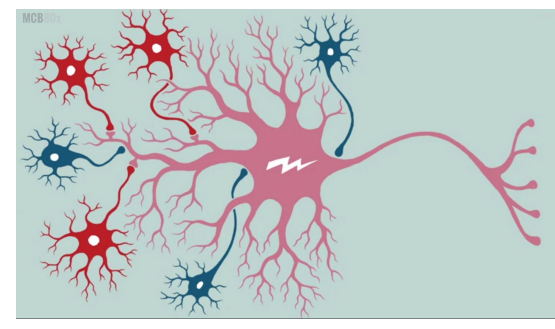
excitatory signals (EPSPs) that start from synapses located far away from the cell body (soma) of the neuron become …. as they travel towards the cell body.
weaker (attenuated)
As dendrites (the branches of a neuron) extend farther from the soma (the cell body), they get ….
thinner, which makes it harder for electrical signals to travel down them without weakening (attenuation).
Non-linear Summation?
refers to the way in which multiple excitatory or inhibitory postsynaptic potentials (EPSPs or IPSPs) combine in a neuron. Unlike linear summation, where the total effect is simply the sum of all inputs, non-linear summation occurs when the interactions between these inputs lead to a different, often more complex result. This can significantly affect whether or not the neuron will fire an action potential.
EPSPs - sum together but it is not strictly linear
For a given ion, driving force diminishess as you approach equilibrium potential.
Voltage-gating may also modulate response (NMDA receptors)
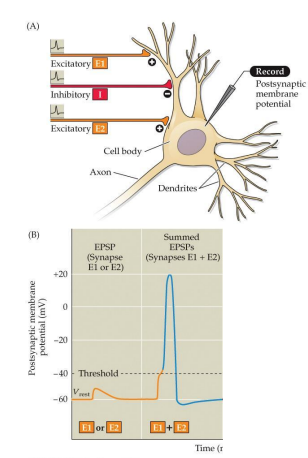
Action potentials fired at hillock spread?
Backwards Passively
Back propagation of action potential
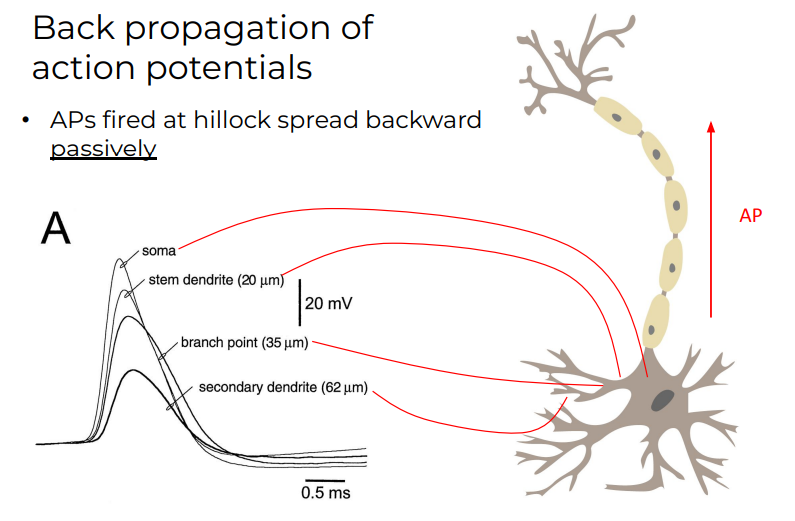
Inhibitory input blocking excitation by? What determines the postsynaptic resonse?
Shunting
Sum of EPSPs and IPSPs sum, IPSPs will shunt EPSPs
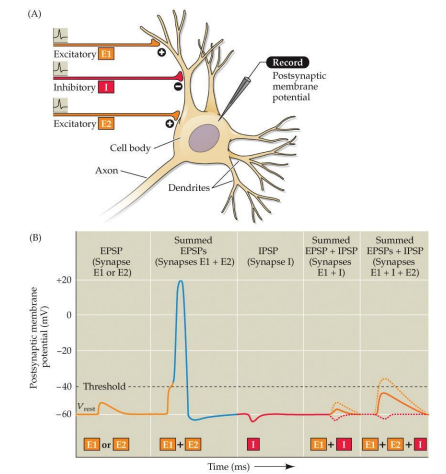
What is shunting?
Shunting Inhibition: This is a type of inhibition that occurs when the opening of ion channels during an IPSP decreases the effect of an EPSP, effectively "shunting" or reducing its amplitude. Instead of fully depolarizing the neuron, the IPSP acts to stabilize the membrane potential and can prevent the neuron from reaching the threshold for firing an action potential.
Temporal Summation
multiple excitatory postsynaptic potentials (EPSPs) occurring at the same synapse over a short period of time can combine to produce a larger postsynaptic response.
EPSPs have rapid rise and …. decline. Synaptic signals can sum…
Single presynaptic neuron can bring postsynaptic neuron to threshold with…
Slow
overtime
multiple excitations
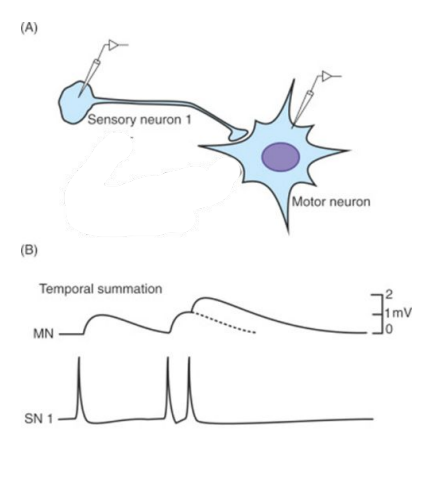
Inhibitory input can block temporal summation by?
Precisely timed IPSPs can block temporal summation of EPSPs
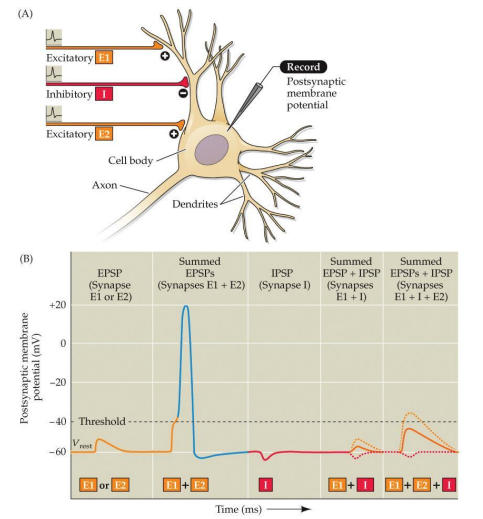
What are the circuit patterns?
Convergence
Divergence
Neuronal divergence? What does it allow?
one neuron activates many target cells.
Allows a single neuron to exert wide influence in nervous system
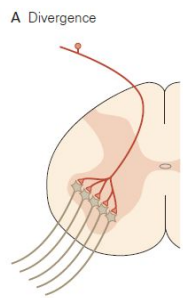
Neuronal convergence? What does it allow?
Multiple nerve cells synapse on single neuron
Target integrates info from multiple sources
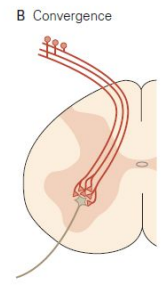
Circuit patterns: recurrence?
Feedback allows for temporal patterning of response
What are the benefits of the nervous system?
Large bodies require coordination within and among cells, tissues, systems
↑ body size compromises cell-to-cell communication
Neurons and nervous systems allow for the rapid and high fidelity communication through specialize electrical and chemical signalling.
↑ body size compromises cell-to-cell communication What 3 things happen?
○ loss of direct contact among cells
○ chemical signals are diffusion limited
○ dissipation of electrical potentials with distance
Central pattern generator
Neuronal network that can produce rhythmic motor patterns without input from:
Networks with inherent oscillations of excitation and inhibition

Neuronal network that can produce rhythmic motor patterns without input from:
• Sensory systems
• Higher centers in the central nervous system